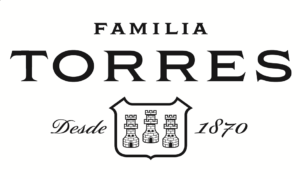
シュルレアリスムからモダニズムへ
フィゲラスから始まり、このコースではカダケス(Cadaqués)とクレウス岬(Cap de Creus)を訪れて、サルバドール・ダリのシュルレアリスムの世界観を探求していきます。コスタ・ブラバ(Costa Brava)沿いに進むと、カミ・デ・ロンダという海岸線沿いの小道があり、パラモス(Palamós)のような小さな漁港の村が並びます。ペラテラーダ(Peratallada)などの中世からある歴史的な村で一休みし、モンセニー(Montseny)山塊を越え、コスタ・バルセロナ(Costa Barcelona)の海岸や漁村で途中下車。そしてバルセロナで終幕を迎えます。
データ
総距離
525km
区間
7
名所
8
主要なエリア
フィゲラス
クレウス岬自然公園、カダケスとポルトリガット(Cadaqués y Portlligat)
中世の村々
ジローナ(Girona)
ビック(Vic)
モンセニー(Montseny)
マレスメ(Maresme)海岸
バルセロナ
区間
第1区間
ダリ、アンチョビ、コスタ・ブラバ
最後のコースでは、ダリ劇場美術館、ポルトリガットのサルバドール・ダリの家博物館(Casa Salvador Dalí)、プボル(Púbol)にあるプボル城(別名:ガラ・ダリ城 – Castillo Gala Dalí)などの、いわゆるダリニアントライアングルと呼ばれるエリアがある地域を巡ります。少し北上し、クレウス岬自然公園に到着。ここは荒々しい海岸線や、険しい断崖、隠れた入り江など魅力に溢れた場所があり、ダイビングやシュノーケリング、カヤックなどを堪能し海の美しさを肌で感じることができます。 自然公園とDOエンポルダ(DO Empordà)のぶどう畑の景色を楽しみながら、次の目的地であるロマネスク様式の修道院、サン・ペラ・ダ・ローダス(Sant Pere de Rodes)修道院へ向かい、また、ポルトリガットのサルバドール・ダリの家博物館も見学します。そこから、イベリア半島で唯一、ギリシャとローマ両方の都市の遺跡を持つアンプリアス(Empúries)の遺跡に向かって進んでいきます。
ART IN FIGUERES
We hear the bells of the church of Sant Pere de Figueres, one of the spaces of Dalí’s life, that genius with the incredible moustache. We will spend the morning tracing the key points on the Surrealist painter’s path, the Dalí Triangle consisting of his hometown, the Port Lligat house and the Castell de Púbol, making some stops along the way. At the Dalí Theatre-Museum we are fascinated by the innumerable details hidden in the artist’s optical illusions. At the Museu del Joguet we see an exhibition about his younger years, and in the Dalí-Jewellery collection we examine a beautiful collection of his jewellery designs. Another interesting visit equally linked to art, in particular local and contemporary art, is the Museu de l’Empordà.
SANT PERE DE RODES
We drive through the vineyards of the Empordà DO, which stretches from the Pyrenees mountains to the beaches of the Mediterranean, to reach the Monastery of Sant Pere de Rodes. The guide tells us entertaining anecdotes about monks growing wine while we visit the church, the two cloisters and the wine cellar. We end the visit at the bar’s lookout, with bird’s-eye views over Port de la Selva and a taste of that wine shaped by the Tramuntana. On the beautiful roads that cross the Cap de Creus Natural Park, we reach the Dalí house in Portlligat, nestled between a white-washed hamlet at the foot of a cove where small fishing boats dock. This house, which Dalí converted into a studio, was a meeting place for many artists and intellectuals of that era, such as his filmmaker friend Buñuel and poet García Lorca. We decide to stop for lunch in Cadaqués, one of those perfect postcard villages on the Catalan coast. Its narrow, steep old town is an invitation to enjoy a calm stroll accompanied by the murmur of the sea.
A HISTORIC BATHROOM
The route continues south, along the Bay of Roses, part of the club of the world’s most beautiful bays, and crossing the Aiguamolls de l’Empordà Natural Park, one of Catalonia’s most varied natural areas. We dedicate the afternoon to history because we want to see the Empúries Ruins, the location where the Greeks and Romans entered the peninsula. We choose a guided tour specialising in the trade and consumption of wine in the ancient world. The privileged location of the ruins, at the foot of the beach, allows us to do something unusual: swim by the pier where the Greek boats docked twenty-five centuries ago. Just six kilometres south of the archaeological site is L’Escala, an official Marine Village because of its historic connection to the sea, where we visited the Anchovy and Salt Museum to learn about the work of the salt curing factories that brought so much prosperity to the town. And of course, we sample the famous L’Escala anchovies in one of the old town’s traditional taverns.
第2区間
アンポルダネットを貫く中世の海沿いの道
モングリ・メダス群島およびバイシュ・テル自然公園(Parque Natural del Montgrí, les Illes Medes i el Baix Ter )の海岸からこの区間はスタートします。エスタルティットーメダス群島(Estartit-Illes Medes)海洋センターでは、海岸の洞窟を探索できるカヤック・アクティビティーが用意されています。 そこから内陸へ進むと、アンポルダネットの魅力的な小さな村に到着。そこで自転車に乗り、パルス、ペラテラーダ、ラ・ビスバル・デ・アンポルダ(La Bisbal d’Empordà)などを通過しながらこの村を探索しましょう。 パラフルジェイ(Palafrugell)に到着したら、ジョセップ・プラの幼少時代の家にあるジョセップ・プラ財団を是非訪れてください。ここで一休みしたら、今度はパラモスにある魚に関するフィッシュセンターを訪れます。ここでは、パルス産のお米と真っ赤なエビを使った料理教室が開かれていたり、水揚げされた魚の競りなどを見学することができます。
MEDIEVAL VILLAGES
We move from the coast to inland Empordà. Behind us is the silhouette of the Montgrí with its castle, a mountain that divides the Alt and Baix Empordà, and access to L’Estartit, the port of departure for a visit to the little Medes Islands, one of the most important reserves of marine flora and fauna in the Mediterranean and a must-visit for scuba divers. After arriving at Peratallada and enjoying a breakfast of sausages and cheeses from the Empordà districts, we embark on a “burricleta” tour (electric-assisted bicycles) of the medieval villages of Empordanet: Peratallada itself, Ullastret, Canapost, La Bisbal d’Empordà, Catalan capital of pottery; and Pals, with its unmistakable walled enclosure.
GIRONA APPLES
Since we are in the lands of Apples of Girona (PGI), we continue to Palau Sator to visit a cider shop where we buy different products made from those apples. Not just the most obvious, cider, but also juices, jams and vinegar. The route approaches the coastline to the Begur coves, another of the towns on the list of Marine Districts and Villages. No one has captured the Empordà districts better than the writer Josep Pla. If we are interested in his literature and his landscapes, we should head to Palafrugell, where the Josep Pla Foundation is located, and Calella de Palafrugell, Charming Village, to explore the writer’s childhood landscapes, as he spent his summers at the family home on Canadell Beach.
COOKING WORKSHOP
We continue to Palamós as we have signed up to one of the cooking workshops at the Espai del Peix. In this dining room, we take a historical and cultural tour of fish consumption and learn how to cook several dishes from what is known as “boat cooking”, created by fishermen. One of the dishes we prepare must include Pals rice and Palamós shrimp. With boats coming in to port to take their catch to the market, which you can also visit to follow the bidding live, we head to the Brugarol bodega near Palamós, which stands out for its architecture in addition to its wines, as it was designed by the RCR studio in the town of Olot, winners of the prestigious Pritzker Prize.
第3区間
トッサの海沿いの道からガローチャまで
この区間のスタート地点であるトッサ・デ・マールを周回し、塀で囲まれたサン・ジャウマ(Sant Jaume)展望台に向かいます。そこでは魚介、ジャガイモ、アリオリソースで作られたシチューのシム・イ・トンバ(cim i tomba = トッサ・デ・マールの魚の名物料理)をいただきましょう。 ジローナへ向かう途中、海の見える雄大な風景の中を通り抜け、ブラナス(Blanes)にあるマリムルタ(Marimurtra)植物園や、 リュレッド・ダ・マール(Lloret de Mar)にあるサンタ・クロティデ(Santa Clotide)庭園を訪れます。 ジローナでは、ロマネスク様式とゴシック様式の教会が立ち並ぶ、伝統的な歴史に彩られた通りや広場のある旧市街を歩きます。人気のテレビドラマ「ゲーム・オブ・スローンズ」のワンシーンに登場する大聖堂を訪れたり、ユダヤ人街(El Call)などを見学。
次のサン・ペレ・デ・ガジガンツ(Sant Pere de Galligants)考古学博物館へと向かう途中には、オニャル(Onyar)川越しに建つ美しい家々を眺めることができます。 オスタレッツ・デンバス(Els Hostalets d’en Bas)でも伝統的な木造家屋を見ることができ、この区間を締めくくります。
TOSSA DE MAR
We drive along the coast to our next stop, Tossa de Mar, leaving the Gavarres mountain range to the north, whose holm oak and cork oak woodlands produce considerable amounts of cork stoppers. We have our first coffee of the day enjoying the views from the walls of Tossa de Mar. Walking by the fishermen’s district of Sa Roqueta we reach el Portal, the access point for Vila Vella where we head out on a guided tour that include the entrance to the Municipal Museum to see a work by Marc Chagall. After walking through the oldest part of this fortified town, we decide to follow the stretch of the Camí de Ronda as far as Cala Giverola to enjoy the view from the Sant Jaume lookout, a balcony with a spectacular perspective on the cliffs and the village with its castle.
FLAVOURS OF GIRONA
Without leaving the coast, we take a short detour along the way to reach Lloret de Mar and visit the Santa Clotilde Gardens, planted on an impressive bluff overlooking the sea. Landscaper and architect Nicolau Rudó was inspired by the Italian Renaissance when he designed this beautiful space. On the seafront staircase flanked by statues of sirens, we cannot stop taking photos to post on social media. In Blanes we find Marimurtra which is another important garden. This botanical garden, where important scientific studies are carried out, was founded by the German Carl Faust. The temple overlooking the cove of Sa Farconera is one of the most photographed places on the Costa Brava. We head inland and to the north towards Girona, an official City with Character. We choose to explore the city through its flavours, taking a gastronomic tour. As well as strolling through its architectural heritage, such as the Cathedral, the Jewish Quarter and the colourful houses on the River Onyar, we taste the xuixo de crema, the brunyols, regional cheeses with pa amb tomàquet and olive oil, fideuà and ice cream made by one of the Roca brothers, among other delicious snacks. Our favourite part is that we are visiting places that the locals love.
THE ROAD TO LA GARROTXA
For golf lovers, there is the option of visiting the PGA Catalunya Resort, with a golf course in a beautiful landscape, but instead we choose to drive along the roads that take us to La Garrotxa in the south, a district marked by its volcanoes and lava-covered landscapes. We spend the afternoon at Hostalets d’en Bas, one of the beautiful villages of the Vall d’En Bas. This municipality, which comprises several small towns, cradles the Fluvià River, the mouth of which we crossed a couple of days before when we passed through the Bay of Roses.
第4区間
コイサカブラ(Collsacabra)の森からモンセニーまで
生い茂った森のあるコイサカブラ(Collsacabra)自然公園は、かつて盗賊たちが隠れる場所として使われていた場所で、ウゾーナ(Osona)、セルバ(Selva)、ガローチャ地区の間の険しい岩山があるエリアまで広がっています。ここではソウ(Sau)貯水池や、中世の伝説に登場するルピ(Rupit)が見られるタヴェルテット(Tavertet)の村などを訪れ、そこから数キロメートル進んだビックでキャンプを張りましょう。この1000年もの歴史を持つ街には、2世紀のローマ時代の神殿や大聖堂などの建造物など、いたるところに歴史と文化が息づいています。 また、地元の手作りソーセージの一種、ロンガニーサ(longanizas)、セカリョネス(secallones)などを試すのもお忘れなく。 生物圏保護地区の一つに指定されるモンセニーに到着すると、どこまでも長く続く道をハイキングやサイクリングで探索することができます。
THE TOWNS OF COLLSACABRA
There are so many options to get to know La Garrotxa, from the air in a balloon, on foot or by bike through the volcanoes, always with good local products on the table. We promise to return as we head towards the province of Barcelona. The first stop of the day is in one of the Charming Towns, Rupit, with its cosy stone cottages in the middle of the Collsacabra, a natural landscape of mountains with dizzying cliffs, streams, and waterfalls. At the Rupit tourism office, we hire a guide to explain us the story of this town in the shelter of an enormous rock, where there was once a castle.
THE CAPITAL OF THE RIVER TER
The road between Rupit and Manlleu crosses the Collsacabra, and taking a detour of just ten kilometres we reach Tavertet, where an easy hike brings us spectacular views of the cliffs from which the village takes its name and the Sau reservoir, fed by the Ter River, at the foot of the Guilleries mountain range and surrounded by forests of exotic pines and fir trees. In Manlleu, a city shaped by the River Ter both in terms of its terrain and its industrial past, we enjoy a very interesting dramatized tour. Assumpta, one of the “Spirits of the Ter”, tells us about the importance of the industrial colonies that were established along the river for the development of Catalonia, mainly related to the work of processing cotton into yarn to serve the textile industries.
VIC SAUSAGES
Our next stop is Vic. Its Plaça Major is one of the most iconic of the Catalan districts, a monumental porticoed square that is always busy during the weekly market. After the guided tour of the city, where we see an outstanding Roman Temple, the cathedral and the streets that formed part of the Jewish Quarter, we entered a century-old drier to try out the famous Vic sausages, the llonganissa and the fuet. We spend the afternoon getting to know the legends of witches and outlaws at the Espai Montseny de Viladrau, an interpretive centre for the Montseny Natural Park, and hiking along a circular route that runs through the heart of the mountain range. This Biosphere Reserve offers landscapes featuring beech, fir and oak forests; we can encounter sequoias like those of Can Casades, or see the riverbank flora alongside the rivers that cross the park. The views from any of Montseny’s iconic peaks are well worth a visit if you have the time to make the climb. We certainly need to return in autumn when the leaves form a beautiful tapestry in the undergrowth and Viladrau holds the Chestnut Fair.
第5区間
モダニズムとインディオのマレスメ
この区間ではモンセニーの山脈からマレスメの海沿いの街へ向かいます。アレンジ・ダ・マール(Arenys de Mar)には、19世紀のインディアーノのモダニズムの家々が道沿いに建ち並び、この地域を特徴付けています。アレンジ・ダ・マールでは、ノウセンティスモ(Noucentist、1900年代主義)派の作詞家であるサルバドール・エスプリウに捧げたサルバドール・エスプリウ会館を訪れることができます。 カネット・デ・マール(Canet de Mar)にはモダニズム建築家リュイス・ドメネク・イ・ムンタネーのハウス・ミュージアムがあり、一方、マタロー(Mataró)には1898年に建てられた、ジュゼップ・プッチ・イ・カダファルクの代表作コイ・イ・レガスがあります。 バルセロナに向かう途中でアレーリャ(Alella)に立ち寄り、サン・アンドレウ・ダ・リャバネラス(Sant Andreu de Llavaneres)産のえんどう豆、マタロー産のじゃがいも、パラフォルズ(Palafolls)産のインゲンマメなど、地元の名産品を使ったメニューをDOアレーリャの白ワインとともに味わいます。
TO THE COAST
Today we descend from the mountains through the Eastern Vallès district to the sandy beaches of the Maresme coastline. Jutting out into the sea, from Calella´s lighthouse we see a part of that coast that we are going to travel today. We start at one of the district’s two Marine Villages, Sant Pol de Mar, walking through its streets to the Les Escaletes urban beach, where we sit in the sand and let time pass while gazing peacefully out at the water.
MODERNISM IN THE MARESME
We continue to the Domènech i Montaner House-Museum, former home of one of the great modernist architects, in Canet de Mar. It is wonderful to see the models for some of his most iconic works, such as the Palau de la Música or the Hospital de Sant Pau. In one of the village cafés, we try “vidrieres modernistes”, or “stained glass”, a type of unusual tea biscuit born of the initiative of local pastry makers. We continue to Arenys de Mar, the other Marine Village of the Maresme coast. In its fishing port, one of Catalonia’s most important, a picturesque auction is held every afternoon where we can see the prized prawns that will later be on the menus of major restaurants. At Arenys de Mar we see a curious kind of modernism, at the Sinera cemetery, a place Salvador Espriu immortalised in his poetry. If you are looking for another view of the town, the port starts off with boats that offer guided tours through the natural environment to enjoy the landscape, the seabed, and the pelagic birds. There is also the chance to do some night boating, watch the stars and hear mythological stories.
ALELLA WINES
Before we head to Barcelona, where we plan to spend the night, we stop at Alella for a visit to a wine cellar, where we open a natural pink Cava that pairs perfectly with the Vallalta strawberries. The wines of Alella, mentioned by Pliny the Elder as “Laletanum wines” in Roman times, come from small vineyards overlooking the sea. Two other interesting attractions in the area are the Circuit de Barcelona-Catalunya, which offers various experiences related high speed racing and hosts one of the world’s most important motorbike events, and La Roca Village, with more than 140 open-air boutiques of national and international luxury brands with savings of up to 60% on the original price, throughout the year, and only 40 minutes from Barcelona. We enter Barcelona, the final point on this stretch of the Grand Tour of Catalonia.
第6区間
文学的な意味を持つ大聖堂とバルセロナ特有のトレンカディス技法(trencadís = 破砕タイル仕上げ)
バルセロナは、このカタルーニャのグランドツアーの始まりと終わりを告げる場所です。 バルセロナには、ガウディやムンタネーをはじめとする有名建築家らの作品が120もあり、モダニズムの一大拠点となっています。代表的なものとして、カサ・ミラ、サン・パウ病院、カタルーニャ音楽堂などが挙げられます。 また大聖堂(カテドラル)は、文化面でも重要な役割を担っています。14世紀のバルセロナを舞台にしたイルデフォンソ・ファルコネスの大ヒット小説「海のカテドラル(La catedral del mar / 英語名 Cathedral of the Sea)」に登場するサンタ・マリア・デル・マル教会を訪れ、ボルン地区を歩く文学ツアーや、バルセロナ大聖堂のツアーでは、バルセロナ最初の守護聖人、サンタ・エウラリアの物語を学ぶなどの体験ができます。
MODERNIST BARCELONA
It is not every day that we have the privilege of waking up in a modernist hotel, and the enchanting spell of modernism’ suggestive forms pushes us to continue to dedicate the morning to this style of architecture. The Modernist Route in Barcelona covers as many as 120 buildings from this beautiful artistic movement, including works by such important architects as Gaudí and Domènech i Montaner. We choose to take a guided tour of some of the most impressive buildings of the Barcelona’s UNESCO world Heritage, such as the Casa Batlló, La Pedrera, the Casa Vicens , the Recinte Modernista Sant Pau and the Palau de la Música Catalana, learning about the origins of this artistic movement, its importance for the city and revealing important details of the façades.
CATALAN CUISINE
We continue with a workshop to learn the technique for making trencadís, one of the characteristic ornamental features of modernism. With basic tools, shards of ceramics and glass we leave with our own piece and great ideas for recycling old building materials. In another modernist building on the Passeig de Gràcia, we attend a cookery workshop where we learn how to prepare dishes such as esqueixada, a traditional salad with cod and tomato among other ingredients, and a delicious crema catalana with its top layer of burnt sugar.
A LITERARY WALK
Having tried the dishes we prepared, it is time for a good walk. We opt for a literary route and are given a choice of viewing settings from The Shadow of the Wind or Cathedral of the Sea. We go for the second option so we can visit the Santa María del Mar basilica in the Born district, and then continue in a leisurely fashion through this lively neighbourhood, where there are plenty of options to enjoy tapas and a glass of wine.
第7区間
バルセロナの市場、料理、漁師たち
カタルーニャ・グランドツアーの最後を飾るのは何といっても美味しい料理です。バルセロナで過ごす2日目には、市内に43か所ある市場のうちの1つで、ミシュランの星付きレストランも買い付けに来るほど新鮮な地元食材を提供している市場を回ります。 漁師が住んでいたエリア、バルセロナネータでは、ワイナリーと海辺の雰囲気を楽しんだり、漁師のギルドにも訪れるなど、大都市にいながら様々な方法で海を満喫することができます。カタマランボートに乗って地中海の夕焼けを眺めながら、この壮大な冒険は終わりを迎えます。
DAWN ON THE SEAFRONT
Our second day in Barcelona will be dedicated to the sea and local products, of course including a visit to one of the city’s markets. With 43 members, the network of Barcelona markets is one of the largest in the world. We head out early to watch dawn and get a little exercise on the city’s seafront. During a walk of just a few minutes, we go from the Barceloneta, a district full of bodegas and tapas bars, clothes laid out on the pavement and a Catalan rumba flavour, to the new architecture that sits on the seafront, featuring some interesting design-focused beach bars that we save for another visit.
FRESH PRODUCTS AT THE MARKET
We’ve got a date at the market, so let’s pick up the hand-made palm frond baskets we bought the day before at one of the shops in the Born district and get ready to let ourselves be advised by our guide on buying the freshest produce, with which we will prepare dishes at a cookery workshop. After enjoying the seafood paella we cook, and taking notes on every step of the recipe so we can repeat our success at home, we head to the fishermen’s guild to see the arrival of the fishing boats and witness the bidding at the auction. It is interesting to see how fishing has survived in such a large metropolis, thanks to a guild that can serve fresh fish to meet the high demand of the Barceloneta restaurants.
A SWIM IN THE MEDITERRANEAN
We end the day as we started it, by the sea, but this time aboard a catamaran to watch the sunset. Soon after leaving port, they unfurl the sails and shut off the engines. After sailing for a moment, and without losing sight of Barcelona, they stop the boat and invite us to take a swim in the Mediterranean; an invitation we are sure to accept. Back on board, we are served an aperitif of seasonal fruit and a glass of Cava, finishing up a great trip as the sun sets behind the Collserola Mountains.








